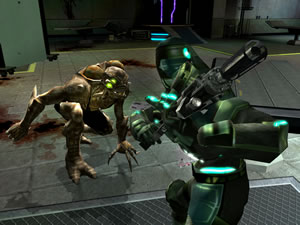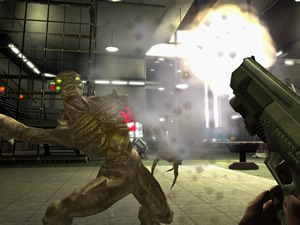An alien autopsy.
Do you ever feel like you’re being followed? Are there crop circles on your front lawn? Do you believe everything you read on the Internet but nothing you see on TV? If so, you might consider abducting Midway’s conspiracy-theory themed first-person shooter, Area 51. Then again, you might also consider wrapping your head in aluminum every time you go outside.
In this console rendition of its arcade classic, Midway has abandoned the familiar light guns for a first-person action romp. There are moments in the first hour of the game – when mutated monsters and secret government soldiers leap onto the screen in hordes – that are reminiscent of the frenzied original. However, the game eventually slows down and hits a stride very much in step with other first-person shooters.
You play as Ethan Cole, an unlucky hazmat specialist sent to clean up an icky viral breakout at the notorious Area 51. During the course of your adventure, you contract the virus and discover that your only hope for a cure is to complete tasks given to you by creepy scientists. While the scientists’ ulterior motives are nice and mysterious, the tasks themselves are of the basic “retrieve ID card” or “activate lift by pushing button” variety. Somehow we expected something a little more…alien.
Controlling Ethan follows the standard dual analog-stick scheme. The face buttons reload, throw grenades, and cycle through weaponry, but this can be a drag since there are no on-screen graphics to let you know where in the cycle each weapon is located. Often, you will find yourself quickly arming your shotgun, then your machine gun, then your alien gun, then your pistol, before finally getting to the arm-mounted sensor that was your intended choice all along.
Besides the frantic gun-toggling, your character will also do a lot of random flailing due to the questionable implementation of an R3 melee attack. When the action gets tense, it’s easy to jam on the R-stick too hard and karate-chop an alien snot-ball you meant to dodge.
Too bad there’s no avoiding Area 51‘s frustrating platform sequences. They’re intended to break up the monotony of shooting your way through the game’s endless corridors, and as far as pitching yourself into a bottomless chasm breaks things up, they’re pretty successful. But after the first few hours, the single-player experience becomes so lifeless that nothing, not even suicidal leaps into the unknown, can bring it back to life.
As with every new FPS, there are some half-hearted attempts to mimic Halo 2, such as the ability to dual-wield. However, you cannot shoot with either hand independently of the other or equip weapons of different types in different hands. On paper, two hands sounds great; in practice, it adds very little to the game.
The only important difference between Area 51 and the run-of-the-mill shooter occurs about a quarter of the way into game. When you contract the virus, a tap of the D-pad will transform you into one of the alien mutants. Although you are not able to use weapons, you do gain the ability to shoot life-sucking parasites at your enemies, replenishing your health while draining theirs. This is an important mechanic because health-packs are rare. Instead of bolting for the health-stations or popping pain-killers when wounded, you’ll switch into mutant mode, send out some parasites, and regain what you lost before turning back into a human. This is a cool mechanic that allows you to stay somewhat involved in the action even while healing.
 But where the mutant variation really shines is in the interesting multiplayer. Area 51‘s online content runs smoothly on both the PS2 and Xbox, offering 16-player games that are drop-in and drop-out. While Deathmatch, Team Deathmatch, and Capture the Flag games are boring but effective, an interesting mode called “Infection” is contagiously fun.
But where the mutant variation really shines is in the interesting multiplayer. Area 51‘s online content runs smoothly on both the PS2 and Xbox, offering 16-player games that are drop-in and drop-out. While Deathmatch, Team Deathmatch, and Capture the Flag games are boring but effective, an interesting mode called “Infection” is contagiously fun.
In “Infection,” all sixteen players begin as humans on a single team. In a nod to The Thing, one of the humans is mysteriously infected, turns mutant, and begins attacking all the other humans. Every human killed becomes a mutant and turns on the players he once called friends. The game dynamic changes drastically as mutants become more powerful and numerous. Humans begin to hide and fortify positions in order to gain time-based “survival bonuses” while mutants rove in animal-like packs. Being one of the last surviving humans is a harrowing and genuinely suspenseful experience.
But if you’re not online, the multiplayer element is slimmer than an alien Jesus on Atkins. The game only supports a one-on-one Deathmatch without any cooperative options. What good is a Mulder without a Scully? Jeez.
Your character, however, is voiced by David Duchovny, our nation’s finest conspiracy theory actor, bar none. His deadpan lines are decent enough, even if he is riffing on his X-files character. Marilyn Manson and Powers Boothe round out the list of talent. Marilyn strains a bit and Boothe delivers a fine performance for an actor I had to look up on the Internet to remember. It’s an interesting trio, even if Area 51 gives them nothing to work with.
The music is even less inspired. A canned music track swells at appropriate times, but the orchestration is utterly forgettable. The sound effects are pretty standard, except that some ambient noises tend to chime in at the wrong times.
 And never in the right place, because interesting, well-developed environments are far and few between. There are some interactive objects – melee a soft-drink dispenser and cans fall out, shoot the cans and they jump across the room – but that hardly counts. Getting free RC cola gets old quick.
And never in the right place, because interesting, well-developed environments are far and few between. There are some interactive objects – melee a soft-drink dispenser and cans fall out, shoot the cans and they jump across the room – but that hardly counts. Getting free RC cola gets old quick.
But not nearly as quick as the dark, industrial motif. Trash-can fires add a little flair, but after a while you feel less like you’re in a military base and more like you’re taking a walking tour of Detroit’s warehouse districts. Area 51‘s other graphical dimensions, such as explosions, physics and framerate, all hold up well, although none of these cover up the featureless corridors you’ll routinely find yourself in. The only environment that breaks the mold is a moon-landing sound stage, in which you fight mutants on the forged set of the “historic moon landing.” Eat frag juice, Buzz Aldrin.
Little tongue-and-cheek moments like that make up for a lot of what might otherwise be sheer drudgery. Unlockable secret files are frequently adorned with the stuff of hilarious paranoid fantasy. The good humor of the programmers shines through every so often and definitely enhances the experience.
But the bulk of the game takes itself far too seriously, so we are forced to admit that it falls short of other serious shooters. Despite some decent multiplayer and a few neat features, Area 51 is a much less intriguing game than military facility. We wish it were a little more out of this world.







